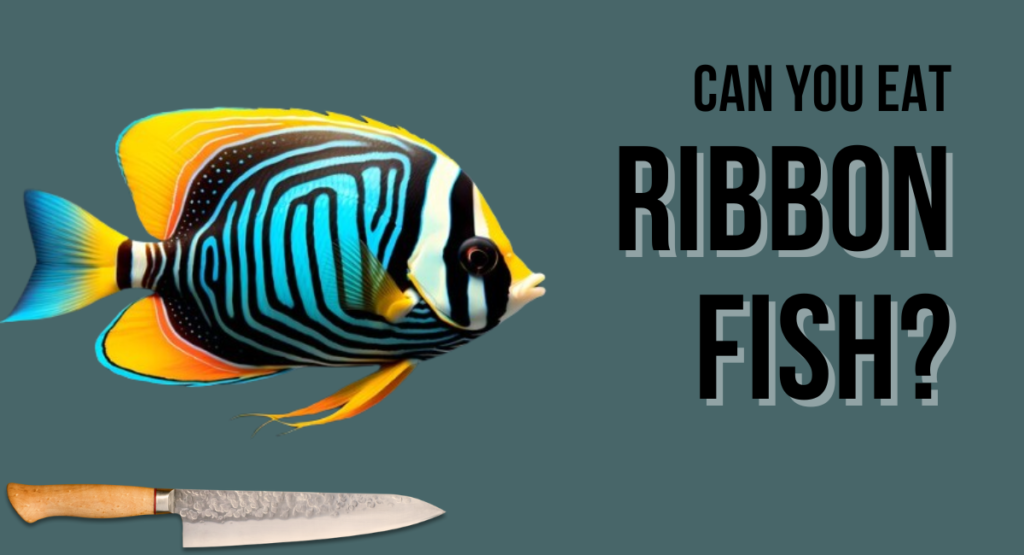Can You Eat Ribbon Fish?
In the vast ocean of culinary delights, there exist countless varieties of seafood that tickle our palate and nourish our bodies. Among these, ribbon fish, known for its distinctive appearance and delicate flavor, holds a special place. Many wonder, “Is ribbon fish edible?” If you’ve ever pondered this seafood mystery, you’re not alone. This blog post aims to explore the world of eating ribbon fish, unraveling its nutritional profile, culinary uses, and the potential health benefits it holds. Let’s explore all things ribbon fish together.

What is a Ribbon Fish?
Before we dive into the edibility and culinary uses of the ribbon fish, let’s familiarize ourselves with what this unique creature is. Ribbon fish, scientifically known as Trichiurus lepturus, is a species of cutlassfish. Belonging to the Trichiuridae family, it is famous for its elongated, often metallic, ribbon-like body.
What Does a Ribbon Fish Look Like?
Ribbon fish, true to their name, have a unique and striking appearance. It Possess long, slender bodies that can extend up to 2 meters. Their sleek and flat bodies, coupled with a silvery sheen, give them a distinctive ribbon-like appearance. They have a long, pointy tail and a sharp, beak-like jaw filled with small, needle-like teeth.
Regions Where Ribbon Fish Are Found
Ribbon fish are a globally distributed species and are found in various parts of the world. They inhabit the tropical and temperate waters of the Atlantic, Indian, and Pacific Oceans. High concentrations of ribbon fish are often found off the coasts of Japan, China, and Korea.
Some Interesting Facts About Ribbon Fish
- Ribbon fish are known for their ability to swim both forwards and backward with equal ease due to their long, ribbon-like bodies.
- They are nocturnal creatures, preferring to stay in deep water during the daytime and moving to shallow areas during the night.
- Ribbon fish are carnivorous and have a diet predominantly composed of small fish and squid.
- Due to their unique body shape, ribbon fish have few predators in the wild.
- The Chinese name for ribbon fish, “Belt Fish,” is derived from their elongated, belt-like appearance.
Are Ribbon Fish Good to Eat? | Can You Eat Ribbon Fish
Yes, ribbon fish are considered a delicacy in many cultures, particularly in Asia. Their lean, firm flesh is known for its delicate flavor, which is often described as mildly sweet and nutty. They’re an excellent source of protein loaded with essential nutrients, making it not only flavorful but also a healthy addition to any diet.
Are Ribbon Fish Dangerous?
There is no inherent danger associated with consuming ribbon fish. They’re not known to carry dangerous parasites or bacteria, unlike some other marine species. However, as with any seafood, it’s recommended to cook ribbon fish thoroughly to ensure food safety.
Are Ribbon Fish Poisonous?
No, ribbonfish are not poisonous. Unlike certain other marine creatures, they don’t produce toxins or poison that could be harmful to humans. They’re safe to consume when prepared and cooked correctly.
Is Ribbon Fish High in Mercury?
The mercury content in ribbon fish is generally low to moderate, making them safer to eat compared to larger predatory fish that often have high levels of mercury. However, like all seafood, it’s advisable to consume them moderately within a balanced diet.
Is Ribbon Fish Healthy?
Absolutely. Ribbon fish are a fantastic source of lean protein, low in saturated fat, and rich in various essential nutrients, including Omega-3 fatty acids, Vitamin D, and minerals like zinc, iodine, and selenium. Consuming ribbon fish can contribute to heart health, support immune function, and aid in maintaining healthy skin and hair.
Religious Acceptability of Ribbon Fish
When considering the religious acceptability of consuming ribbon fish, it largely depends on the dietary laws of the religion in question.
In Ribbon Fish Halal
In Islam, seafood is generally considered halal, as stated in the Quran, Surah Al-Ma’idah (5:96): “Lawful to you is game from the sea and its food as provision for you and the travelers…” As ribbon fish don’t possess any harmful traits or features and are not listed as haram, they can be considered halal for consumption.
However, some Islamic scholars, including Shia scholars, argue that only fish with scales are halal, and since ribbon fish do not have scales, they would be considered haram.
In Ribbon Fish Kosher?
In Judaism, the laws of Kashrut dictate which foods are considered kosher and can be consumed. According to these dietary laws, only animals that have fins and scales are considered kosher, meaning ribbon fish would not be acceptable for consumption.
In Christianity
In Christianity, no specific dietary laws or restrictions pertain to seafood. Fish is often mentioned positively in the Bible, particularly in Jesus’ miracles of feeding the masses with fish and loaves of bread. As such, ribbon fish would be considered acceptable for consumption by Christians.
In Hinduism
In Hinduism, the consumption of seafood is generally frowned upon, particularly for Hindus who refrain from eating meat. However, some sects do permit the consumption of certain seafood, including fish. Ribbon fish would fall under this category and be considered permissible to consume by Hindus.
In Buddhism
Buddhism does not have any specific dietary laws or restrictions regarding seafood. Many followers of Buddhism opt for vegetarian or vegan lifestyles, reflecting their commitment to kindness and non-violence towards all creatures. As such, ribbon fish may not be considered acceptable for consumption by some Buddhists.
Spiritual Significance of Ribbon Fish
There are no specific spiritual or symbolic meanings associated with ribbon fish. However, in some cultures, like Korea, they symbolize good fortune and prosperity. Additionally, their unique appearance in the water can be seen as mesmerizing and even spiritual by some individuals.
Nutrition Facts
To understand the health impact of consuming ribbon fish, let’s explore its nutritional facts.
Breakdown of the Nutritional Content of Ribbon Fish
Ribbon fish is a nutritious seafood choice, providing significant protein in a 100-gram serving. It’s an excellent option for those on a high-protein diet and is rich in heart-healthy Omega-3 fatty acids. Apart from these, Ribbon Fish is high in vitamins, especially Vitamin B12 and D, and minerals like selenium and iodine. It is low in fat, and those fats it does contain are primarily unsaturated fats, which are beneficial for maintaining a healthy cholesterol level.
Health Benefits Associated with Consuming Ribbon Fish
Including Ribbon Fish in your diet offers numerous health benefits due to its rich nutritional profile. The high protein content helps in building and repairing body tissues, making it particularly beneficial for people involved in physical activities. Ribbon Fish is rich in Omega-3 fatty acids that not only promote heart health but also bolster brain function, potentially decreasing the likelihood of cognitive disorders. The vitamin and mineral content boost overall immunity, support bone health, and aid in maintaining optimal thyroid function. Moreover, the low fat content makes Ribbon Fish a suitable choice for those striving for weight management or adopting a low-fat diet.
What Does Ribbon Fish Taste Like?
When it comes to the taste and texture of Ribbon Fish, imagine a delicate balance of sweetness with a subtly briny undertone. Ribbon fish is renowned for its unique, delicate flavor that pleases the palate. Its meat is firm, lean, and mildly sweet with a subtle nutty undertone. The taste is typically less ‘fishy’ than some other seafood varieties, making it a popular choice among individuals who prefer a milder flavor profile. For those new to seafood or individuals who prefer a less overpowering flavor, Ribbon Fish is an excellent choice. The texture of ribbon fish is smooth and slightly buttery, adding to its overall gastronomic appeal. When properly cooked, it can be a versatile addition to various dishes, absorbing the flavors of accompanying ingredients while retaining its inherent taste.
How to Eat Ribbon Fish
Various cooking methods can be applied to ribbon fish based on personal choice, given its mild taste and sturdy texture that’s suitable for grilling, roasting, or pan-frying. Many enjoy ribbon fish simply seasoned with salt and pepper, grilled to perfection, and served alongside a fresh salad. Baking ribbon fish with a dash of lemon juice and a sprinkle of herbs is another popular preparation method. Pan-frying ribbon fish with a thin layer of batter or breadcrumbs until they turn golden gives you a crunchy exterior with a moist and tasty inside. Always ensure the fish is thoroughly cooked to prevent any foodborne illnesses. Furthermore, ribbon fish is also used in various Asian cuisines, particularly in soups and stews, where its unique flavor stands out. Regardless of the cooking method chosen, ribbon fish’s versatility makes it an appealing choice for seafood lovers.
Preparing and Cooking Ribbon Fish
Preparing and cooking Ribbon Fish is relatively simple, making it an easy choice for home cooks. Let’s look at some basic steps to cook Ribbon Fish:
How to Clean Ribbon Fish – Step-by-Step Guide
Cleaning Ribbon Fish is a straightforward process that requires a few simple steps. Place the fish on a clean cutting board, make a shallow cut along the belly from head to tail, avoiding deep cuts to prevent puncturing internal organs. Next, open up the cut and remove the internal organs. Rinse the inside of the fish thoroughly under cold running water to remove any remaining viscera. Then, cut off the head and tail if desired. Lastly, use a knife or fish scaler to remove the shiny, silvery scales. Once the fish has been thoroughly cleaned, it is ready to be cooked in your preferred culinary style.
How to Cook Ribbon Fish | Various Cooking Methods for Ribbon Fish
Ribbon Fish is a versatile ingredient, perfect for grilling, imparting a slightly smoky flavor that enhances its taste. Grilling allows the fish to maintain its firm texture while absorbing the flavors of marinades or seasonings. Baking is another popular method, often involving a mixture of herbs, spices, and some butter or olive oil to keep the fish moist. Steaming is a healthier option that preserves most of the nutrients and brings out the natural flavor of the Ribbon Fish. It can also be stir-fried or deep-fried, resulting in a crispy exterior and tender interior.
Popular Recipes Featuring Ribbon Fish
Ribbon Fish is a versatile ingredient that can be prepared in a variety of delectable ways. Grilled, baked, pan-fried, or steamed—endless possibilities for cooking this fish. Here are two popular recipes featuring Ribbon Fish:
1) Grilled Chili Lime Ribbon Fish
Ingredients:
- 4 Ribbon Fish fillets
- Juice from 2 limes
- 1/4 cup olive oil
- 1 tsp chili powder
- Salt and pepper to taste
Instructions:
- Preheat your grill to medium-high heat.
- In a small bowl, mix together the lime juice, olive oil, chili powder, salt, and pepper.
- Brush the marinade on both sides of the Ribbon Fish fillets.
- Place fillets on the grill, cooking for 5-6 minutes on each side until opaque and flaky.
- Remove from heat, let it rest, and serve hot.
2) Pan-Fried Ribbon Fish with Lemon Butter Sauce
Ingredients:
- 4 Ribbon Fish fillets
- Salt and pepper to taste
- 1/2 cup all-purpose flour
- 3 tbsp butter
- Juice from 1 lemon
Instructions:
- Season the Ribbon Fish fillets with salt and pepper on both sides.
- Coat them lightly in flour, shaking off any excess.
- In a large skillet, melt the butter over medium-high heat.
- Add the fillets to the pan and cook for 3-4 minutes on each side, until golden brown.
- Remove from heat and squeeze fresh lemon juice over the fillets.
- Serve hot with your choice of sides or sauces.
Tips for Cooking Ribbon Fish
- Dry the fish thoroughly before cooking to prevent sticking to the pan or grill.
- Avoid overcooking Ribbon Fish to maintain its delicate texture and flavor.
- Marinate the fillets for at least 30 minutes before cooking for maximum flavor.
- Serve with a squeeze of lemon juice or a side of tangy sauce to complement the slight sweetness of the fish.
Safety Concerns & Considerations
Potential Risks or Concerns When Consuming Ribbon Fish
While Ribbon Fish is generally safe to eat, awareness of potential risks is crucial. The primary concern is the freshness of the fish, as consuming spoiled seafood can lead to foodborne illness. Ribbon Fish is also a wild-caught fish, so it can sometimes ingest harmful pollutants, such as heavy metals, from contaminated waters. Although Ribbon Fish doesn’t fall into the category of high-mercury fish, it’s still important to consider the quality of the waters where the fish was caught. Furthermore, mishandling or incorrect preparation of the fish might raise the possibility of cross-contaminating it with other food items.
Guidelines to Ensure Safe Consumption
Ensuring safe consumption of Ribbon Fish largely involves careful handling and proper cooking. Firstly, buy fresh fish from reliable sources and pay attention to its smell, color, and texture – it should smell like the ocean, have a shiny, metallic surface, and firm to the touch. Once at home, refrigerate the fish immediately and consume it within a day or two. When preparing Ribbon Fish, use separate chopping boards and utensils for the fish and other ingredients to prevent cross-contamination. Cook the fish to an internal temperature of at least 145°F (63°C) to eliminate potential bacteria or parasites.
FAQs
Freshness of Ribbon Fish can be determined by its odor, color, and consistency. Fresh Ribbon Fish should smell like the ocean, have a shiny, metallic surface, and feel firm to the touch.
Yes, Ribbon Fish can be frozen for later use. Make sure it’s well-cleaned and stored in a sealed container or freezer bag to retain its freshness.
Yes, most white fish like cod, haddock, or grouper can be substituted for Ribbon Fish in these recipes if needed.
Steamed veggies, rice, or a fresh salad make excellent accompaniments with Ribbon Fish.
Ribbon Fish is not classified as a high-mercury fish, making it safer for pregnant women to eat compared to other types of fish. However, it’s always recommended to consult with a healthcare provider.
Conclusion
Ribbon Fish is a delicious and nutritious seafood option that can be prepared using a variety of cooking methods, offering a myriad of flavors to seafood enthusiasts. Whether you favor the smoky taste of grilling, the delicate flavor from baking, the crispy texture from pan-frying, or the natural essence from steaming, the versatility of Ribbon Fish caters to all culinary preferences. Moreover, people eat ribbon fish not just for its taste but also for its nutritional virtues. However, the dietary acceptability of certain foods, including seafood, can vary depending on religious beliefs. For instance, within the Islamic faith, marine creatures like Ribbon Fish are generally deemed Halal, meaning permissible under Islamic law. Nonetheless, interpretations can vary among different Islamic sects, so if in doubt, it’s always beneficial to consult with a knowledgeable religious leader or scholar within your community.






